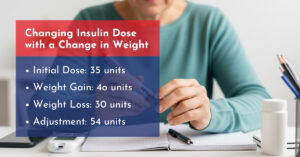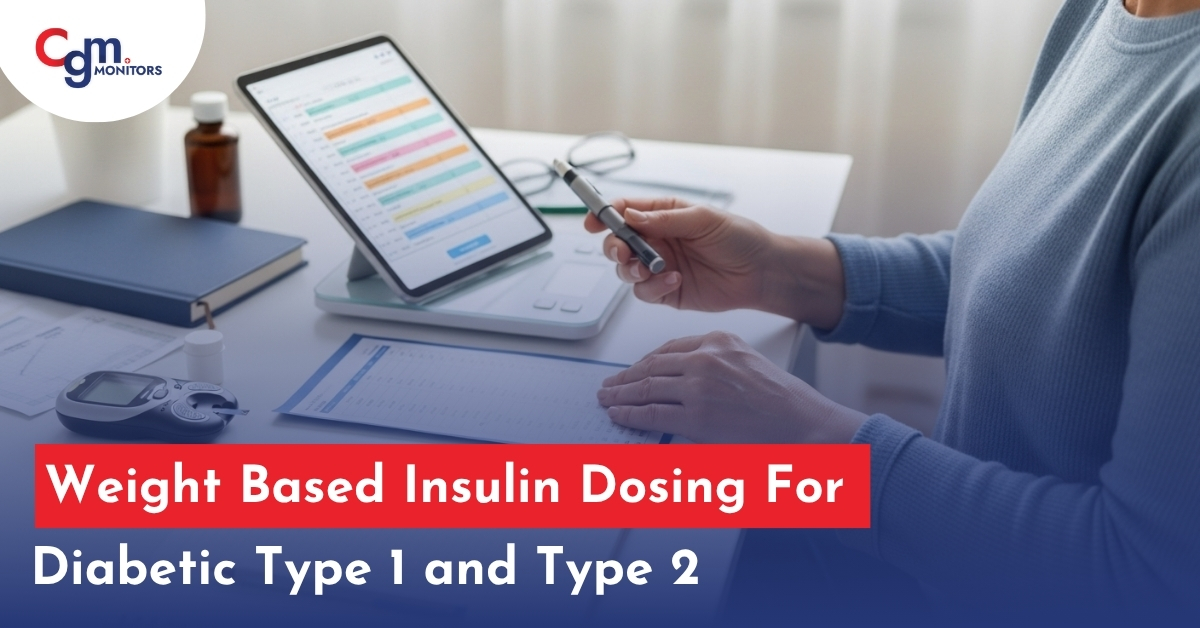Table of content
It is widely accepted and used in clinical guidelines and hospital order sets.The weight based insulin dosing is a method that calculates insulin doses according to a person’s body weight, typically in units per kilogram (U/kg) instead of a fixed dose. The method helps tailor dosing more accurately, especially at the initiation of insulin therapy, and may result in better glycemic control with less hypoglycemia than flat doses, if carried out carefully.
What is Weight-Based Insulin Dosing?
Insulin is a life-saving therapy for millions of people living with diabetes, but finding the correct dose can be tricky. Too little insulin leads to high blood sugar, while too much increases the risk of hypoglycemia. Traditionally, some patients were started on a fixed insulin dose, regardless of their weight or insulin sensitivity.
This method is widely used because it provides:
- A standardized starting point for patients
- Clinically accurate dosing
- A reduced risk of hypoglycemia
- A personalized approach to insulin therapy
It is especially useful for:
- Newly diagnosed Type 1 diabetes
- Insulin-dependent Type 2 diabetes
- Hospitalized patients under glucose control
- Transitioning from oral medications to insulin
- Setting initial insulin pump parameters
This method is supported by ADA (American Diabetes Association) guidelines and remains a gold standard in modern diabetes care.
Weight-Based vs. Fixed Dosing
The key difference between fixed and weight-based insulin dosing lies in personalization.
- Fixed dosing: A standard dose is prescribed to most patients, such as 10 or 20 units per day. This may be simple but often fails to consider weight, insulin resistance, or kidney health.
- Weight-based dosing: Insulin needs are calculated according to body weight, creating a tailored plan that minimizes the risk of under- or overdosing.
Study Highlight: In a trial of people with Type 2 diabetes and renal insufficiency, researchers compared 0.5 U/kg/day vs. 0.25 U/kg/day using glargine and glulisine. Both groups achieved similar average glucose (~174 mg/dL), but hypoglycemia occurred in 30% of patients at 0.5 U/kg/day vs. 15.8% at 0.25 U/kg/day.
Formulas for Weight-Based Insulin Dosing
Total Daily Dose (TDD) Formula: TDD = 0.4 to 0.6 units × body weight (kg). When calculating insulin doses, several formulas and safe ranges are recommended:
- Type 2 diabetes (outpatient start): ~0.3 U/kg/day
- Renal-impaired inpatients: 0.25–0.5 U/kg/day
- Safe upper limit: ≤0.6 U/kg/day (above this, hypoglycemia risk rises significantly)
- Acute hyperkalemia: 0.1 U/kg IV insulin is safer than a flat 10-unit dose
This range varies based on insulin resistance, age, and diabetes type:
| Type of Patient | Recommended Units/kg/day |
|---|---|
| Newly diagnosed Type 1 diabetes | 0.4–0.5 U/kg |
| Lean adults | 0.4 U/kg |
| Average-weight adults | 0.5 U/kg |
| Insulin-resistant adults | 0.6–0.8 U/kg |
| Obese adults | 0.7–1.0 U/kg |
These ranges are based on clinical studies and endocrinology treatment standards.
Still pricking fingers? Pricking fingers is no longer required just to check blood glucose. Continuous glucose monitors (CGMs) monitor your glucose data 24/7, and most of the latest ones, such as Freestyle Libre 2 Plus Sensors, are automatic insulin delivery (AID) compatible as well.
Weight-Based Insulin Dosing Chart
This chart provides a simplified reference for clinicians and patients:
| Body Weight (kg) | TDD (0.5 U/kg) | Basal Dose (50%) | Bolus Dose (50%) |
|---|---|---|---|
| 50 kg | 25 U | 12 U | 13 U |
| 60 kg | 30 U | 15 U | 15 U |
| 70 kg | 35 U | 17 U | 18 U |
| 80 kg | 40 U | 20 U | 20 U |
| 90 kg | 45 U | 22 U | 23 U |
| 100 kg | 50 U | 25 U | 25 U |
This chart is for initial estimations. Actual doses must be fine-tuned based on glucose readings and medical evaluation.

Common Mistakes and Safety Risks
Weight-based dosing is effective, but safety must always come first. Here are key precautions:
- Start low: Use 0.25–0.4 U/kg/day for underweight patients or those with kidney disease.
- Avoid exceeding 0.6 U/kg/day: Higher doses increase the chance of hypoglycemia.
- Monitor daily glucose: Especially important during initiation or dose changes.
- Educate patients: Teach proper injection techniques, site rotation, and signs of hypoglycemia.
Did you know? Metformin, often prescribed for Type 2 diabetes, can help offset insulin-related weight gain when used together with insulin therapy. Let s explore how metformin helps you to lose weight in a few months.
Monitoring Insulin Therapy: The Role of CGMs
Traditional self-monitoring with finger pricks is useful but often inconvenient. Thankfully, Continuous Glucose Monitors (CGMs) now provide real-time glucose tracking without constant fingersticks.
Benefits of CGMs in Weight-Based Dosing
- Predict and prevent hypoglycemia: Some CGMs, such as the Dexcom G7, provide alerts before glucose levels drop too low.
- Track glucose trends: Allows better basal and bolus insulin adjustments.
- Improve safety during activity and sleep: Reduce overnight lows and exercise-related hypoglycemia.
- Data sharing with providers: CGM reports can be reviewed remotely, ensuring personalized adjustments.
Modern CGMs like Freestyle Libre 3 Plus Sensors and Dexcom G7 are also compatible with many automated insulin delivery (AID) systems, making weight-based insulin dosing even more precise.
Key Terms and Formulas
| Term | Typical Value / Formula | Notes |
| TDD starting dose | 0.3 U/kg/day | Type 2 outpatient |
| Renal-impaired inpatient | 0.25–0.5 U/kg/day | Safer range |
| Safe upper limit | 0.6 U/kg/day | Beyond raises hypo risk |
| Acute hyperkalemia dose | 0.1 U/kg IV | Safer than a flat dose |
Final Takeaways
- Weight based insulin dosing is considered safer and more effective than fixed dosing for many people with diabetes. Furthermore, to avoid hypoglycemic (low sugar) events, CGM systems may help.
- While initiating insulin therapy, 0.3 U/kg/day may be the best; afterwards, remember that doses under the 0.6 U/kg/day threshold reduce hypoglycemia risk. Weight changes should prompt dose reassessment.
- With regular monitoring and adjustments, weight-based dosing facilitates precise insulin therapy, minimizes adverse events, and empowers people living with diabetes to lead healthier lives.
Frequently Asked Questions
Is 20 units of insulin a lot?
It depends on the person. For someone who weighs around 70 kg, the typical total daily insulin (TDD) would be around 21 units (0.3 x 70). The difference also lies in the type of insulin you consume, i.e., basal or basal-bolus.
How many units of insulin are normal?
It depends on the person’s weight and needs. On average, people need around 0.3 to 0.6 units of insulin per kilogram of body weight in 24 hours, i.e., 70 x 0.3 = 21, this 21 is the units of insulin a 70kg person may require.
How to determine insulin dose & insulin dose calculator by weight?
A good starting point is 0.3 units of insulin per kg of body weight each day. Then, divide it between basal (long-acting) and bolus (fast-acting) insulin, like a 50/50 split. Doses may be adjusted following the “1800 Rule” or “500 Rule”.
What’s the Rule of 1800?
It helps calculate how much 1 unit of fast-acting insulin will lower your blood sugar. To find this, divide 1800 by your total daily insulin dose (TDD). This gives you how much your blood sugar will drop per unit of rapid insulin. For example, 1800 ÷ 30 (units you consume in 24 hrs) = 60. This means 1 unit of rapid insulin will lower your blood sugar by about 60 mg/dL.
Disclaimer: This blog is only for informational purposes. Always check with your healthcare specialist before taking any medical action.







Write a comment
Your email address will not be published. All fields are required